| Albert is a brewer of beer
and a good one. His techniques are old ones as are those of other
craftsmen in the town. He prepares his mixture of barley, malt, water
and yeast as his father did before him and sells it from his house,
which is one of the local taverns. Even though he lives in the 21st
century, life for him is much as it was for his ancestors in the 14th.
Albert resides in Bruges, Belgium, a
city whose life is like a living tapestry interwoven with complicated
designs by skilled craftsmen like himself and the hands of time.
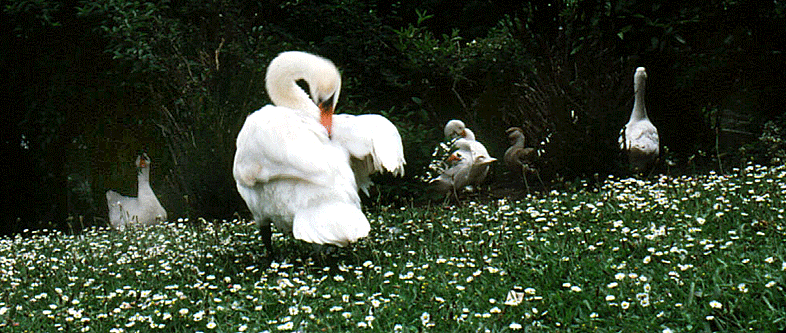
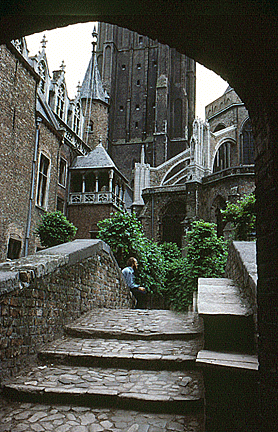 Narrow winding cobblestone streets with rows of high-peaked house lead
through a maze of canals to the Markt, the central square from which
goods were and are traded with merchants from around the world. During
the height of her power in the fourteenth century, Bruges existed on her
trade. Craftsmen, who were members of strong unions called guilds,
worked fantasies in gold and wood on the many beautiful buildings in the
town. The city was hardly a clean and sanitary place—dogs fought over
garbage dumped from windows, the air was thick
with the smells of cooking and charcoal fires, and traffic was a serious
problem. Narrow winding cobblestone streets with rows of high-peaked house lead
through a maze of canals to the Markt, the central square from which
goods were and are traded with merchants from around the world. During
the height of her power in the fourteenth century, Bruges existed on her
trade. Craftsmen, who were members of strong unions called guilds,
worked fantasies in gold and wood on the many beautiful buildings in the
town. The city was hardly a clean and sanitary place—dogs fought over
garbage dumped from windows, the air was thick
with the smells of cooking and charcoal fires, and traffic was a serious
problem.
This isn’t so today. Craftsmen like Albert still practice age-old skills
but in much cleaner surroundings. The air smells like sweet perfume from
all the flowers, and garbage is stored in
polyurethane bags. However, traffic is still a problem but is now one of
tour buses rather than ox carts.
Bruges’ residents and the stillness of its canals sustain the city’s
medieval character and peaceful atmosphere.
The blue-green waters lap gently at the walls of ancient houses and pass
serenely under the spans of 100 bridges, for which the town’s founders
named it.
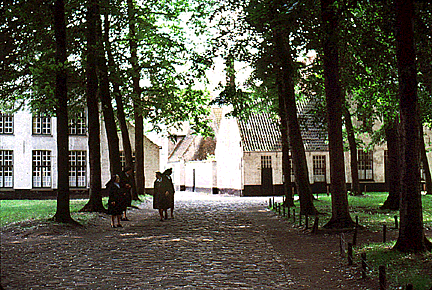 The peaceful quality of the beguinage, a retreat for secular
nuns, hasn’t changed since the 7th century. Baldwin II, then Count of
Flanders, fortified the town and made it his chief residence. A powerful
force in northern Europe during the 1300's, Bruges was the northern
counter-part of Venice–with trade in exotic spices, jewels, rich
fabrics, and wines. Its residents became wealthy and created a quality
of life as rich as a tapestry. The peaceful quality of the beguinage, a retreat for secular
nuns, hasn’t changed since the 7th century. Baldwin II, then Count of
Flanders, fortified the town and made it his chief residence. A powerful
force in northern Europe during the 1300's, Bruges was the northern
counter-part of Venice–with trade in exotic spices, jewels, rich
fabrics, and wines. Its residents became wealthy and created a quality
of life as rich as a tapestry.
Then early in the 15th century, tragedy struck. A gradual silting of the
River Zwyn, which connected Bruges with the
North Sea, choked off prosperity and the town ground to a halt. Time and
two World Wars seemed to pass Bruges by, so that today, it’s a perfectly
preserved medieval town.
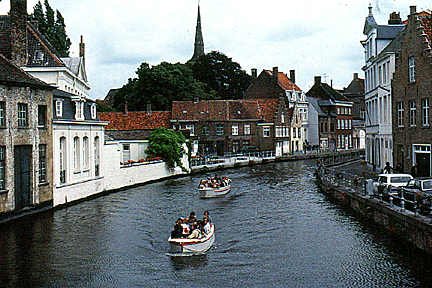 Bruges is a day-town, a place which gets many tourists during daylight
hours due to its close proximity to several large population centers.
The modern town bustles, yet is blended naturally with the old town of
the Middle Ages. Bruges is a day-town, a place which gets many tourists during daylight
hours due to its close proximity to several large population centers.
The modern town bustles, yet is blended naturally with the old town of
the Middle Ages.
The typical atmosphere is one of contemporaneous crowds and historical
quietness, but it isn’t a tourist trap. A favorite with both foreign and
Belgian tourists, Bruges contains some of the best examples of the
Flemish school of painting, of which it was the center. But the city
goes on living even after the last tour bus pulls out, and a special
kind of peace comes over the town.
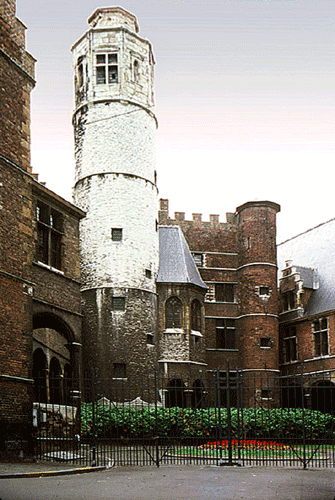 Every medieval town had a high belfry atop an elaborate town hall.
Bruges’ belfry, whose famous bells toll the time hourly, is the symbol
of it independent spirit and the central point
of the old town. It is appropriate that the Tourist Information Center,
one of the best of its kind, should be located directly beneath it in
the magnificent Gothic town hall. Friendly, English-speaking aides
dispense all sorts of information as well as making reservations.
There’s even a small lounge for weary sightseers. Every medieval town had a high belfry atop an elaborate town hall.
Bruges’ belfry, whose famous bells toll the time hourly, is the symbol
of it independent spirit and the central point
of the old town. It is appropriate that the Tourist Information Center,
one of the best of its kind, should be located directly beneath it in
the magnificent Gothic town hall. Friendly, English-speaking aides
dispense all sorts of information as well as making reservations.
There’s even a small lounge for weary sightseers.
Bruges is best seen by walking (a printed guide is available at the
Tourist Center). Even though there’s an excellent bus system in town,
trains to nearby cities, and a slower water transport system, the charm
of the city should be felt up close. There are enough treasures to fill
several days. However, with good planning, the best can be packed into a
day. Comfortable shoes are recommended.
Before walking, why not take a canal boat tour of Bruges. For a mere
$2.65 for adults, 31.25 for children, a half-hour leisurely cruise with
English commentary will acquaint the visitor
with all the major sights. Another option is a more private ride in a
horse-drawn fiacre, or buggy seating up to five people, available in
front of the town hall. Either one of these tours should be taken first
before the visitor gets too tired to enjoy them.
Staying in Bruges is a delightful experience. Most of the sixty hotels
and pensions are old and charming homes that have been refurbished on
the inside, although small—as few as ten rooms. At several, the Duc
de Bourgogne in particular, the museum-like atmosphere is luxurious—and so is the almost
$150-165 a night price tag.
Service is excellent and
the food a gourmet's dream. Accommodations become plainer and more
reasonable the farther away they are from the Markt.
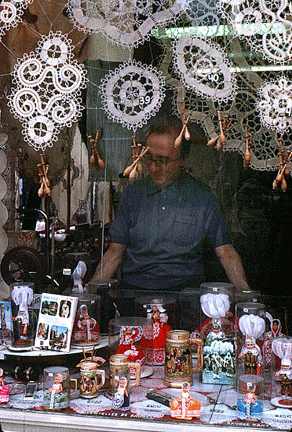 Food is superb, and one need not spend a fortune to eat well. Flemish
specialties, served at such appealing restaurants as the Panier d'Or on
the Markt, include beef stew cooked in beer, and a thick soup of chicken
or fish, both age-old recipes. Prices tend to be high, but reasonably
priced cafe-style restaurants on, the Markt offer good fixed price menus
with ample to excessive portions. Since luncheon is the busiest time,
dinner should be had before 8 P.M., when most restaurants close. Food is superb, and one need not spend a fortune to eat well. Flemish
specialties, served at such appealing restaurants as the Panier d'Or on
the Markt, include beef stew cooked in beer, and a thick soup of chicken
or fish, both age-old recipes. Prices tend to be high, but reasonably
priced cafe-style restaurants on, the Markt offer good fixed price menus
with ample to excessive portions. Since luncheon is the busiest time,
dinner should be had before 8 P.M., when most restaurants close.
Bruges reached its peak as a trading city, and its shops today offer
attractive-goods at reasonable prices. Everything from Belgian lace to
delicious confections are available in shops along the Hoogstraat,
Bruges' chief shopping street. Most shops are open from around 9 A.M.
until 6 or 7 P.M. and until 9 P.M. on Fridays. Special markets are held
in the Markt on Saturday mornings, and on Saturday and Sunday afternoon
(from March to October), a flea market is held on the Dwyer.
The summer season, Bruges' busiest, offers many interesting activities—apertif
concerts, organ recitals, street and trade fairs, carillion concerts–to
name but a few. Of special interest is the International Fortnight óf
Music held every August and the Procession of the Holy Blood held in
early May.
Albert and his fellow craftsmen will continue their lives as their
ancestors did in the past and as their children will do in the future.
The old town of Bruges will continue as it has for centuries providing a
quiet retreat from the bustle of this century for the lucky few who take
the time to get to know her.
< Back to
Travel Articles
Go to the next travel article > |
